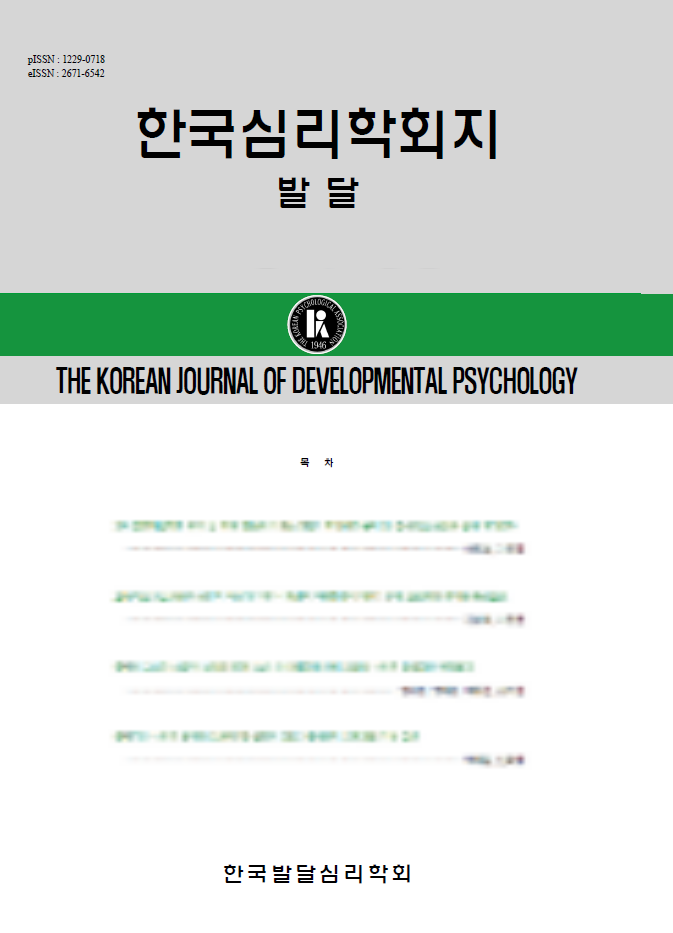open access
메뉴
open access
메뉴 ISSN : 1229-0718
ISSN : 1229-0718

본 연구는 한국어 습득 아동의 증거성표지 습득 양상을 검토하고자 한 아동의 자료를 중심으로 자발적 산출의 양상을 검토하고, 어머니의 관련 입력 언어를 분석하였다. 특히, 만 2-3세에 주로 산출되는 증거성표지와 정보 출처 관련 어휘를 검토하였고, 어머니의 입력 언어에서 관련 표현들의 빈도 분석을 실시하여 입력언어와의 관계를 살펴보았다. 또한 한국어와 유사한 일본 아동과 양육자의 관련 자료를 비교 분석하여 언어 간 입력 언어 차이에 따른 산출 양상도 비교, 분석하였다. 자발적 산출 분석 결과 직접 경험을 나타내는 표지 및 어휘의 사용이 간접 경험이나 보고의 표지보다 양육자와 아동 모두에게서 높았으며, 한국과 일본의 ‘대’, ‘보다’, ‘듣다’ 사용 빈도를 비교한 결과 한국 양육자가 일본 양육자에 비해 어휘 사용이 상대적으로 높고, 형태소 사용 빈도가 상대적으로 낮은 것으로 나타났다. 비록 제한된 자료들의 검토이나 이러한 결과는 증거성표지나 관련 어휘의 습득이 인식론적으로 보다 직접적인 것에서 간접적인 것의 순서로 이루어지고 있음을 시사하며, 인식론적 상태에 따라 화자가 전달하는 정보의 확실성이 달라진다는 것을 이해하게 되는 시기와도 관련이 있음을 시사한다.
The purpose of the current study was to investigate the developmental pattern of evidential markers and related verbs by examining the child’s natural production and mother’s input language. First, two audio-recorded corpora of Korean mother-child dyad’s natural production were analyzed for frequency, age of emergence and productive use of evidential markers and related verbs. Also, the result of the corpora analyses was directly compared to one Japanese mother-child dyad’s recorded speech corpus. The analyses of natural production revealed that children begin using direct experience marker/verb before hearsay or inference markers/verbs. Furthermore, mother’s input pattern appeared to be aligned with the child’s use of these markers/verbs. These findings suggest that the acquisition of evidential markers and related verbs proceed from those that describe direct experience to hearsay or indirect inference or conjecture, implying that such order of acquisition might play a role in the later development of information certainty judgments on the basis of evidentiality.
김경애 (2002). 증거표지와 정보의 출원. 論文集,33, 51-58.
김동욱 (2000). 한국어 추측표현의 의미차이에 관한 연구. 국어학, 35, 171-197.
송경안, 이기갑 (2008). 언어유형론. 월인.
송재목 (2007). 증거성(Evidentiality)과 주어제약의 유형론. 형태론, 9, 1-23.
송재목 (2009). 기획논문 : 인식양태와 증거성. 한국어학, 44, 27-53.
송재목 (2011). 한국어 증거성표지의 중복실현. 比較文化硏究, 22, 355-375.
이기갑 (2006). 한국어의 양태(Modality) 표현. 담화·인지언어학회 학술대회 발표논문집, 67-83.
이화인 (2012). 한국 아동의 증거성표지 발달 과정: 산출,이해, 확실성 차이에 대한 이해를 중심으로, 중앙대학교 대학원 석사학위논문.
최영은, 이화인, 장나영 (2010). 정보 원천 표현에따른 정보 확실성 이해의 발달. 한국심리학회지: 발달, 23(2), 109-124.
최영은, 장나영, 이화인 (2011). 증거성표지의 이해, 산출과 마음이론발달의 관련성 연구. 한국심리학회지: 발달, 24(1), 93-108.
최영은, 장나영, 이화인 (2012). 학령전기 아동의증언판별, 증거성표지 이해와 정보확실성 판단 능력 발달. 한국심리학회지: 발달, 25(1),135-152.
최영은 & Kaufman, A. (2009). 정보 원천 표현에대한 암묵적 이해의 발달. 한국발달심리학회추계 학술심포지엄 발표 논문. 서울대학교.
Aikhenval'd, A. Y. (2004). Evidentiality. New York: Oxford University Press.
Aksu-Koc, A. (1988). The acquisition of aspect and modality. Cambridge: Cambridge University Press.
Aksu-Koc, A., Ogel-Balaban, H., & Alp, E.(2009). Evidentials and source knowledge inturkish. New Directions for Child &Adolescent Development, 125, 13-28.
Au, T. K., Dapretto, M., & Song, Y. K. (1994). Input vs. constraints:Early word acquisition in Korean and English. Journal of Memory and Language, 33(5), 567-582.
Aydin, C., & Ceci, S. J. (2009). Evidentiality and suggestibility: A new research venue. New Directions for Child and Adolescent Development, 125, 79-93.
Choi, S. & Gopnik, A. (1995). Early acquisition of verbs in Korean: A cross-linguistic study. Journal of Child Language, 22, 497-530
Davis, C., Potts, C., & Speas, M. (2007). The Pragmatic Values of Evidential Sentences. Proceedings of SALT 17. Ithaca, NY: CLC Publications.
de Villiers, J. G., Garfield, J., Gernet-Girard, H., Roeper, T., & Speas, M. (2009). Evidentials in tibetan: Acquisition, semantics, and cognitive development. New Directions for Child & Adolescent Development, 125, 29-47.
Gleitman, L. R. (1990). The structural sources of verb meanings. Language acqusition, 1(1), 3-55.
Hoff, E. (2009). Language Development(4th ed.). Belmont, CA: Wadsworth, Cengage Learning.
Jaswal, V. K., Croft, A. C., Setia, A. R., & Cole, C. A. (2010). Young children have a specific, highly robust bias to trust testimony. Psychological Science, 21, 1541-1547.
Kim, M., McGregor, K. K., & Thompson, C. K.(2000). Early lexical development inEnglish- and Korean-speaking children:Language-general and lnaguage-specificpatterns. Journal of Child Language, 27,225-254.
Lee, C. (2009). Acquisition of Modality. In C. Lee, G. B. Simpson, & Y. Kim (eds.), The Handbook of East Asian Psycholinguistics, 3, pp. 187-220. Cambridge, UK:Cambridge University Press.
MacWhinney, B. (2000). The CHILDES Project: Tools for analyzing talk. Third Edition. Mahwah, NJ: Lawrence Erlbaum Associates.
Matsui, T., Yamamoto, T., & McCagg, P.(2006). On the role of language in children'searly understanding of others as epistemicbeings. Cognitive Development, 21(2),158-173.
Matsui, T., & Fitneva, S. A. (2009). Knowing how we know: Evidentiality and cognitive development. New Directions for Child & Adolescent Development, 125, 1-11.
Naigles, L.R. (2002) Form is easy, meaning is hard: Resolving a paradox in early child language. Cognition, 86, 157-199.
Papafragou, A., Li, P., Choi, Y., & Han, C. H.(2007). Evidentiality in language andcognition. Cognition, 103, 253-299.
Speas, P. (2004). Evidentiality, logophoricity and the syntactic representation of pragmatic features. Lingua, 114(3), 255-276.
Tardif, T. (1996). Nouns are not always learned before verbs: Evidence from Mandarin speakers’ early vocabularies. Developmental Psychology, 32(3), 492-504.
Tincoff, R., & Jusczyk, P. W.W (1999). Some Beginnings of Word Comprehension in 6-Month-Olds. Psychological Science, 10(2), 172-175.
Willett, T. (1988). A cross-linguistic survey of the grammaticization of evidentiality. Studies in Language, 12(1), 51-97.
